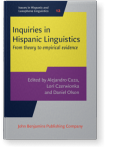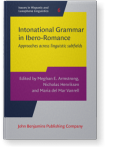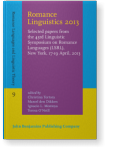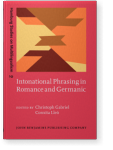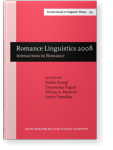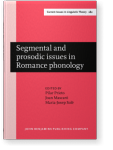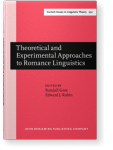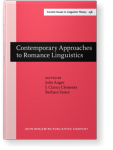Laura Colantoni
List of John Benjamins publications for which Laura Colantoni plays a role.
Articles
2024 Chapter 14. Acoustic properties of word-final vowels and the acquisition of gender in Spanish-English heritage speakers Multilingual Acquisition and Learning: An ecosystemic view to diversity, Babatsouli, Elena (ed.), pp. 380–402 | Chapter
This chapter explores whether contact-induced reduction in the inventory of Spanish unstressed vowels due to contact with English impacts the development of gender morphology and concord in Spanish-English bilinguals, through the comparison of recent findings from narratives elicited from… read more
2020 The perception and interpretation of sentence types by L1 Spanish–L2 English speakers Linguistic Approaches to Bilingualism 10:4, pp. 499–529 | Article
While the L2 perception of segmentals has been investigated, our knowledge of the L2 perception of intonation is limited. Moreover, it is unclear how context affects L1 transfer. This study investigates the perception of English sentence types by adult L1 Spanish speakers across tasks varying in… read more
2016 The mestizo speech: Participant selection and task choice in L2 speech Inquiries in Hispanic Linguistics: From theory to empirical evidence, Cuza, Alejandro, Lori Czerwionka and Daniel Olson (eds.), pp. 131–148 | Article
The goal of this chapter is to reflect on methodological practices in second language (L2) speech concerning participant selection and task choices. To frame the discussion, I turn to two central issues in cultural studies: the concept of mestizaje and the connection between speech and writing.… read more
2016 Task-related effects in the prosody of Spanish heritage speakers and long-term immigrants Intonational Grammar in Ibero-Romance: Approaches across linguistic subfields, Armstrong, Meghan E., Nicholas Henriksen and Maria del Mar Vanrell (eds.), pp. 1–24 | Article
We compare the extent to which Spanish heritage speakers and long-term immigrants in the United States differ in their intonation of broad focus declaratives, and propose that the between-group variability is motivated by the specific language learning/literacy conditions of each group. Results… read more
2016 Age effects and the discrimination of consonantal and vocalic contrasts in heritage and native Spanish Romance Linguistics 2013: Selected papers from the 43rd Linguistic Symposium on Romance Languages (LSRL), New York, 17-19 April, 2013, Tortora, Christina, Marcel den Dikken, Ignacio L. Montoya and Teresa O'Neill (eds.), pp. 277–300 | Article
This study explores the perception of consonantal and vocalic contrasts in two groups of Spanish-English bilingual speakers: heritage speakers and long-term immigrants. We test the discrimination of Spanish stops and mid and high vowels via an AX discrimination task with natural stimuli consisting… read more
2011 Broad-focus declaratives in Argentine Spanish contact and non-contact varieties Intonational Phrasing in Romance and Germanic: Cross-linguistic and bilingual studies, Gabriel, Christoph and Conxita Lleó (eds.), pp. 183–212 | Article
This paper revisits the hypothesis that Buenos Aires Spanish (BAS) early peak-alignment and downstep are the result of contact with Italian. In order to support the hypothesis, I compared BAS to other contact (Spanish-Guarani) and non-contact varieties. Overall results confirmed previous findings… read more
2010 Where are hiatuses left? A comparative study of vocalic sequences in Argentine Spanish Romance Linguistics 2008: Interactions in Romance, Arregi, Karlos, Zsuzsanna Fagyal, Silvina Montrul and Annie Tremblay (eds.), pp. 23–38 | Article
We investigate the realization of iV sequences in a contact (CV) and non-contact (NCV) variety of Argentine Spanish. We test the following hypotheses: (1) diphthongization is increasing in CV; (2) diphthongization is sensitive to the etymological origin of the sequence; (3) delateralization in CV… read more
2007 Voicing-dependent cluster simplification asymmetries in Spanish and French Segmental and prosodic issues in Romance phonology, Prieto, Pilar, Joan Mascaró and Maria-Josep Solé (eds.), pp. 109–129 | Article
In the present work, we build upon the proposal outlined in Colantoni & Steele (2005b) that asymmetrical patterns of Spanish and French stop-liquid cluster simplification are conditioned by liquid type and stop voicing. Specifically, using data from four Romance varieties (Argentine and Chilean… read more
2005 Phonetically-Driven Epenthesis Asymmetries In French and Spanish Obstruent-Liquid Clusters Theoretical and Experimental Approaches to Romance Linguistics: Selected papers from the 34th Linguistic Symposium on Romance Languages (LSRL), Salt Lake City, March 2004, Gess, Randall and Edward J. Rubin (eds.), pp. 77–96 | Article
2004 Reinterpreting the CV Transition: Emergence of the glide as an allophone of the palatal lateral Contemporary Approaches to Romance Linguistics: Selected Papers from the 33rd Linguistic Symposium on Romance Languages (LSRL), Bloomington, Indiana, April 2003, Auger, Julie, J. Clancy Clements and Barbara Vance (eds.), pp. 83–102 | Article


